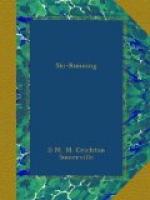Never ski along, or above, or below a dangerous-looking slope under doubtful conditions.
Never go for a tour without making sure beforehand that the route you propose to follow is a safe one.
Always carry out any instructions your Guide or the experienced leader of your party may give. If you have any sudden doubt about the safety of the slope you are on, make quickly for the nearest rocks sticking up.
If there are trees near get among them as quickly and quietly as you can.
If the snow begins to slip and you see no chance of Ski-ing quickly away from the dangerous place, get your Skis off. This is where toe bindings may be safer than heel bindings as they come off quicker.
Never follow a track across a slope, about which you are doubtful, thinking hopefully that the runner who cut it knew more than yourself.
Never cut a track across a dangerous place at your own risk if there is the slightest chance of misleading another runner into danger later.
Remember that though you yourself may be on a safe slope, the slope above or below you may be so steep that the snow may slip off by itself and your slope may be involved. This applies equally to running along the bottom of a valley. The slopes on either side may be dangerous, and if the snow slips you will be buried.
There are so many perfectly safe runs that it is folly to risk being killed by an avalanche, when it can easily be avoided by a little forethought and common sense.
Even if you do not mind the risk yourself, think not only of your people waiting below, but also of the people who have to come and look for your body. There have been several cases where the search party have been overwhelmed by a second avalanche while digging for people carried away by the first.
January and March are probably the most dangerous months from the avalanche point of view. In January the fresh snow is apt to slide before it has settled. A few days after a new snowfall, most of the avalanches will have come down and the ordinary runs will be safe again, but every snowfall entails the same risk. There are some slopes where the snow will never stay in February, but unless a Foehn wind or rain make the snow heavy, most slopes are pretty safe below a gradient of 25 deg..
In March when the thaw begins more avalanches will fall. These usually come down well-known tracks and can easily be avoided for this reason.
This chapter may appear to be somewhat intimidating, but it is better to be safe than sorry. Very few experienced Ski runners get into avalanches and if ordinary precautions are taken and the advice of experts followed beginners need have no fear.
The Ski-ing maps usually show the more dangerous places, but every runner should keep his own eyes open and learn all he can of snow-craft in order to be able to explore new country as he becomes proficient.




